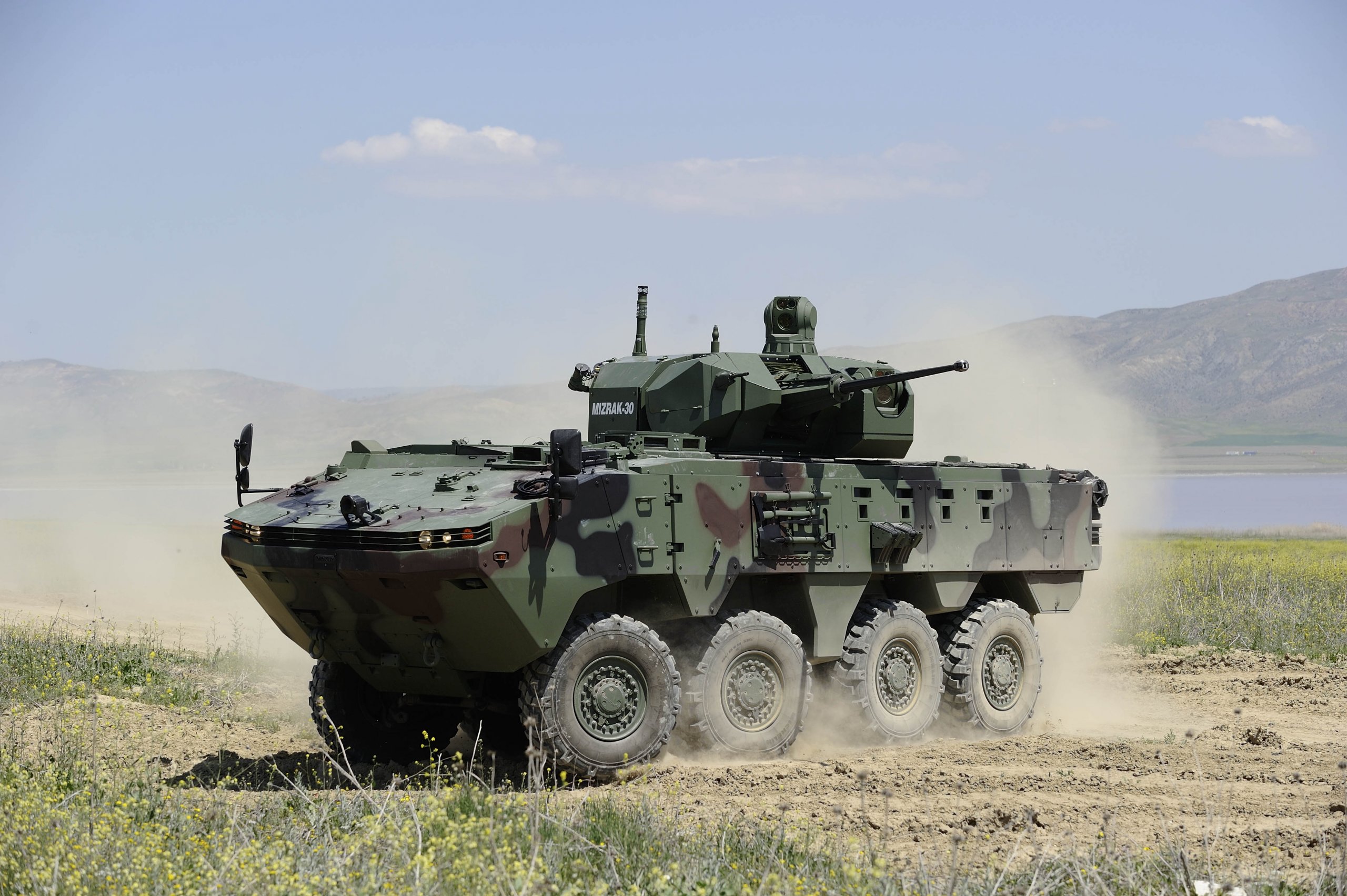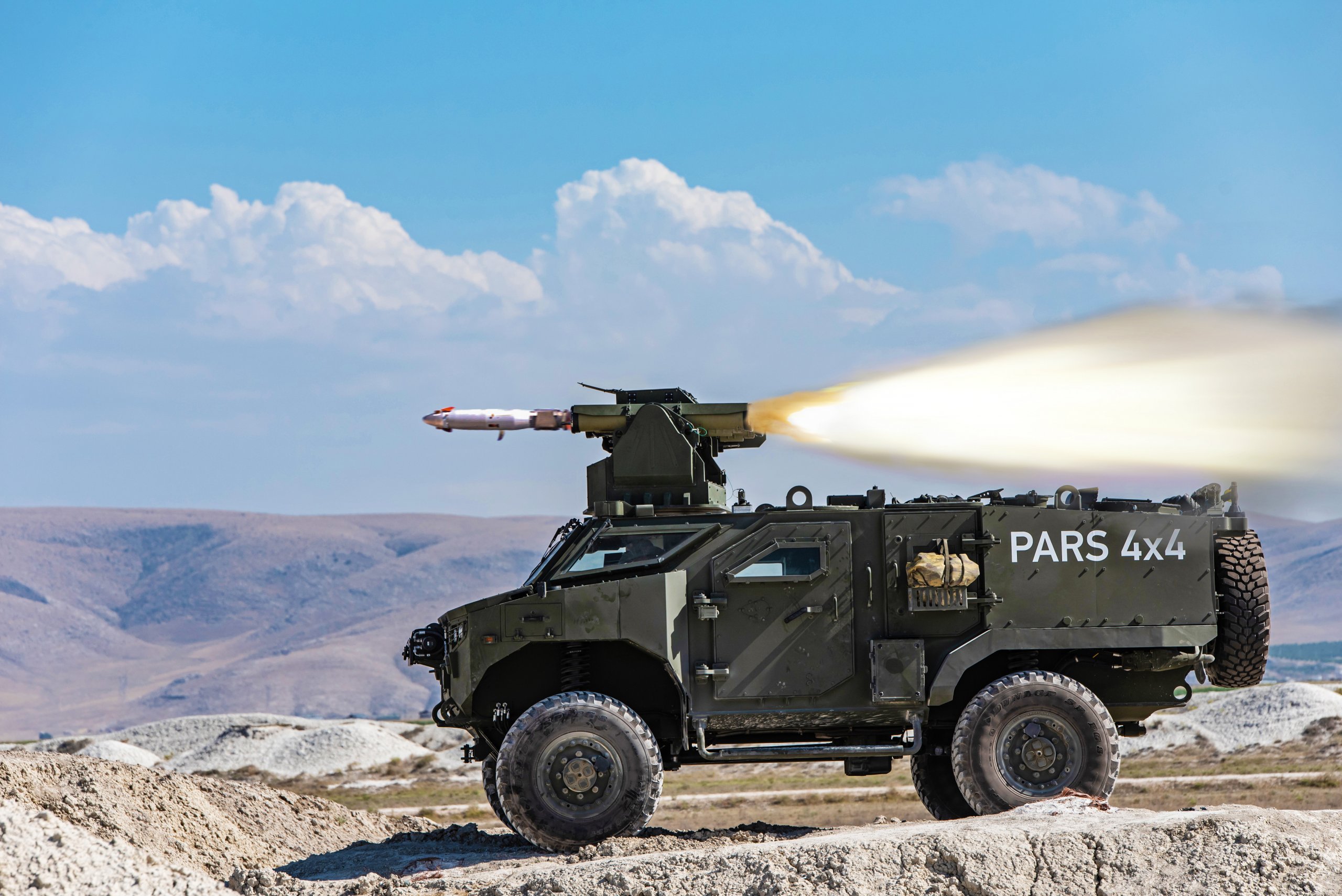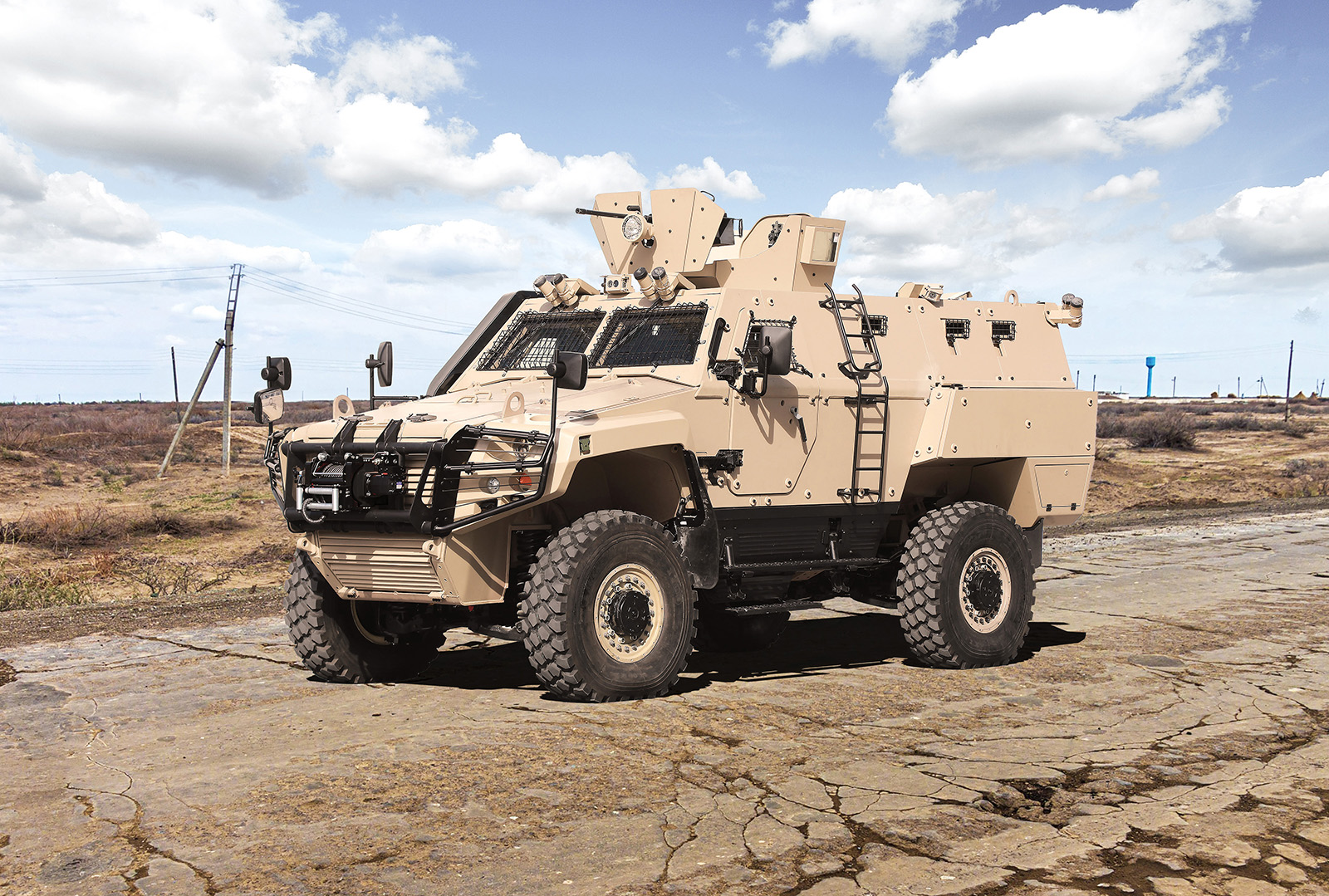
Armoured vehicles designed and manufactured by Turkish companies are now finding their own export markets.
For many years the Turkish Land Forces Command (TLFC) deployed large numbers of foreign designed and built armoured fighting vehicles (AFV) including US M48 and M60 main battle tanks (MBTs) and US M113 series of armoured personnel carriers (APC) and variants.
More recently large numbers of surplus Porsche Leopard 1 and Krauss-Maffei Leopard 2 MBTs have been supplied by Germany.
Today, Turkey is self-sufficient in all classes of AFVs ranging from MBTs through to tracked and wheeled APCs as well as wheeled vehicles suitable for the internal security vehicle (ISV) role.
In addition to the prime contractors of Turkish AFVs, there are also a number of key Turkish sub-contractors with Aselsan being responsible for fire control systems (FCS) and optronics and MKEK for guns and ammunition.
The two largest AFV contractors in Turkey are FNSS Savunma Sistemleri and Otokar, both of whom have built large numbers of AFVs for the home and increasingly demanding export markets.

In addition to designing AFVs, both of these contractors are involved in the design, development and production of turrets and remote weapon stations (RWS) for their own platforms as well as other export customers.
FNSS Savunma Sistemleri is a joint venture between the now BAE Systems of the USA (49 percent) and the local company of Nurol (51 percent). This company was originally established to undertake production of the Turkish Infantry Fighting Vehicle (TIFV) based on the Armoured Infantry Fighting Vehicle (AIFV) developed in the USA by the now BAE Systems (at that time FMC) which was also adopted by Belgium and the Netherlands. Turkey took delivery of 2,249 TIFV in four basic configurations.
Further development for the export market resulted in the Armoured Combat Vehicle 15 (ACV-15) with the 15 relating to the typical gross vehicle weight (GVW) in tonnes.
Export sales of the ACV-15 have so far been made to Malaysia and the United Arab Emirates (UAE).
A stretched version of the ACV-15, called the ACV-19, has more volume and payload enabling it to undertake a wider range of battlefield missions. This has been sold to Malaysia (eight fitted with Thales 120mm mortar), Saudi Arabia and the UAE.
FNSS has also been engaged in the upgrading of the M113 series APC to the M113A4 standard. The largest customer has been Saudi Arabia with the work being carried out in country.
The company has also developed two new tracked AFVs as a private venture, the Kaplan 30 New Generation (NG) AFV and Kaplan 20 NG which can both be optimised to meet the end user’s specific operational requirements.
To meet the TLFC need for a highly mobile tank destroyer, FNSS developed the Kaplan 10 and Pars (4×4) platforms which are both amphibious and fitted with a remote controlled turret (RCT) armed with the Russian Kornet-E or Roketsan Mizrak-U anti-tank guided weapons (ATGW).

The company is also producing the Marine Assault Vehicle (MAV) which will be deployed by the new Turkish Landing Helicopter Dock (LHD). It is amphibious, propelled in the water by two water jets positioned either side at the rear. It is fitted with a RWS armed with a 12.7mm machine gun (MG) and a 40 mm automatic grenade launcher (AGL).
A total of 27 MAV are being supplied under a contract awarded in 2017 of which 23 are in APC configuration, as well as two command post and two armoured recovery versions.
Under sub-contract to Aselsan, FNSS is providing the Air Defence System Platform for their HISAR surface-to-air missile (SAM) system and the Korkut twin 35mm self-propelled anti-aircraft gun (SPAAG) which have now entered production for Turkey. These leverage from their well-established ACV-15 and ACV-19 platforms.
From Tracks to Wheels
While originally concentrating on tracked AFVs, FNSS has now moved into the wheeled AFV market with the Pars family of 8×8 and 6×6 vehicles.
The first customer was Malaysia which ordered a total of 257 Pars 8×8 in many configurations with first vehicles coming from Turkey followed by local production in Malaysia. Havelsan completed the installation of its AV8 Pars armoured ground vehicle simulator at the KEM Syed Sirajuddin military facility in 2020. The AV8 simulator consists of two trainers, one for advanced driving and the second for operators of the weapon, sensor and turret. Both simulator cabins can be used simultaneously.
The second customer was the Royal Army of Oman who received 172 Pars III of which 145 were in the 8×8 configuration and 27 in the 6×6 configuration.

In 2019 Turkey placed a contract for 100 units, five of which were for the Turkish Gendarmerie with the remaining 95 for the Army, of which 50 are 8×8 and 45 are in 6×6 configuration.
The latest FNSS export development is the Kaplan Medium Tank (MT) which is the result of co-operation between FNSS and PT Pindad of Indonesia who is the launch customer for 18 vehicles. The MT is fitted with the Belgian John Cockerill Defense C3105 turret armed with a 105mm rifled gun fed by an automatic loader with a 7.62mm co-axial machine gun.
The company has also built a batch of 12 Armoured Amphibious Combat Earthmover (AACE) for the TLFC and recently won a contract from the Philippines for an undisclosed number of units, so the production line will start again with first deliveries in 2023.
The company has also supplied the TLFC with the Armoured Amphibious Assault Bridge (AAAB) which is being offered on the export market as the Otter Rapidly Deployable Amphibious Wet Gap Crossing System.
This can be used as a Military Load Class 21 (one unit), MLC 85 (two units) or MLC 120 (three units) in the ferry mode or 12 can be connected together to form a 150m long bridge.
Otokar started designing light AFVs such as the Akrep (Scorpion) 4×4 light reconnaissance vehicle and a 4×4 light APC suitable for the IS role based on a long wheel base Land Rover chassis.
By early 2021 the company had built some 33,000 vehicles, including trucks and AFVs, selling to 36 countries all over the world. The smaller AFVs were followed by the bestselling Cobra (4×4) based on automotive components of the US AM General Expanded Capacity Vehicle (ECV).
The baseline Cobra APC has a crew of two and can carry up to seven dismounts with a variety of roof mounted weapons. There are also more specialised versions, including a reconnaissance and an amphibious variant.
This was followed by a brand new design called Cobra II (4×4) which has more volume and payload and can undertake a wider range of battlefield missions. In 2021 the company launched the Cobra Mine Resistant Ambush Protected (MRAP) version on the export market which is claimed to combine a high level of survivability and mobility in a modular package. By March 2021, Otokar had built over 4,000 Cobra (4×4) in all versions.

For the export market Otokar developed the Arma in both 8×8 and 6×6 configurations which share 90 percent common components and can be fitted with a wide range of weapons. The 8×8 can be fitted with a wide range of weapons including a two person turret armed with a 105mm gun. The first customer for the Arma 6×6 was Bahrain in the APC configuration with a second customer ordering the 8×8 model.
Further development of the Arma 8×8 resulted in the larger Rabdan for the UAE with the first batch consisting of 100 units fitted with the complete turret of the Russian BMP-3 IFV armed with a 100mm gun (which can also fire a guided projectile), 30mm co-axial cannon and 7.62mm co-axial machine gun.
Production of the Rabdan is now underway in the UAE as Otokar has a joint venture company with Edge of the Abu Dhabi Government and Al Jassor.
As a private venture, Otokar has designed and built the Tulpar IFV (which is called the Safa by the Gulf Cooperation Council) and the more compact Tulpar-S tracked vehicles with the latter being amphibious.
Otokar has not neglected MRAP type vehicles and has developed Kaya I and Kay II as well as the Kale, with all of these being of the 4×4 type. The company is also investing in new technology and has built the prototypes of the Akrep II (4×4) which is being marketed in full electric, diesel and hybrid configurations.
As previously stated, the Turkish Nurol company owns 51 percent of FNSS but then went onto develop the Ejder (6×6) amphibious APC and 70 units were supplied to Georgia, although all marketing of this family of vehicles has now ceased.
Nurol is now concentrating on 4×4 wheeled AFVs with the first of these being the Edjer Yalcin which has been built in significant numbers for the home and export markets.
BMC is a relative newcomer to the AFV domain having built large numbers of trucks for the home and export markets. This provided the basis for the design, development and production of wheeled AFV, especially those optimised for IS type operations.
Otokar was responsible for the design, development and testing of prototypes of the Altay MBT, but the production contract was awarded to BMC who had no experience in the manufacture of highly complex AFVs such as MBTs.
The Altay is a conventional design with driver at front, turret armed 120mm smooth bore gun in the middle and power pack at the rear. It has a computerised FCS with commander and gunner using stabilised day/night sights with an eye safe laser rangefinder. The first production contract for the Altay MBT is for 250 units, with additional orders expected plus more specialised versions.

BMC moved into the design, development and production of MRAP type vehicles, initially for the home market but then for export. The Kipri (4×4) MRAP was supplied first to Turkey but then to export customers include Libya, Qatar and Somalia.
Further development has resulted in a Kipri 6×6 model which offers more volume and payload so enabling it to undertake a wider range of battlefield missions including as an ambulance.
Other BMC MRAP type vehicles include the Vuran (4×4) which can carry nine people and the more compact Amazon (4×4) which can carry seven people.

The Vuran is also used as the platform for the Sungur surface-to-air missile (SAM) system. On the roof is a pedestal with two pods each containing two fire and forget infra-red homing missiles. It has also been fitted with the Aselsan Alkar 120mm turntable mounted mortar fitted with a semi-automatic loading system.
A more recent Turkish AFV contractor is Katmerciler who developed the Hizar (4×4) with the first customer being Turkey. An undisclosed customer in Africa placed a contract worth $20.7 million in July 2019.
Overhaul and Upgrade
While the Turkish AFV industry is capable of the design, development and production of a wide range of AFV, tracked and wheeled, the TLFC has extensive facilities for the overhaul and upgrading of AFVs.
It has upgraded the M48 MBTs to the M48T standard and conducted a major upgrade for the M60 to the M60T standard based on an Israeli design and including new armour, power pack, 120mm smooth bore and new computerised FCS.
It also upgraded large numbers of M113 series APC and variants to the diesel powered M113 standard which has the local designation of the M113A2T2. In addition it has converted upgraded M113 to more specialised roles such as Engineering Squad Armoured Vehicle, Ambulance and Command Post vehicles.
The TLFC has also converted Leopard 1 MBT hulls to transport and launch the German Krauss-Maffei Wegmann Leguan bridge system. They are also responsible for the Firtina 155mm/52 calibre self-propelled howitzer based on the South Korean K9 Thunder. Turkey has also designed and built an ammunition resupply vehicle for the Firtina which is based on components from M48 tanks.
by Christopher F. Foss













